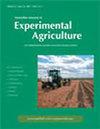Approaches for assessing some attributes of feed-base systems in mixed farming enterprises
引用次数: 33
Abstract
Improving the feed-base to better balance livestock demands with the variation in feed supply can improve the sustainability and productivity of livestock enterprises. This paper outlines some approaches and tools that can be applied to the assessment of new feed options and/or potential changes to the feed-base in mixed farming systems. Demonstrations of strategic aspects of designing feed systems include: whole-farm feed planning using simple tools, such as the MLA Feed Demand Calculator, that enable iterative changes to the balance between feed supply and demand to be considered simultaneously; assessing production and environmental risks of different feed-base systems using simulation models (e.g. APSIM, GRAZPLAN); and using bio-economic models (e.g. MIDAS) to investigate the impact of a new feed source on whole-farm profitability and the optimal balance of other feed sources and livestock production system. Also included is an example of an approach to identifying opportunities and seasonal triggers for a tactical response for utilising an alternate feed source (e.g. grazing a grain crop). The importance of economics and risk as factors for assessing feed-base systems is demonstrated. In particular, the marginal value of extra feed supply is a critical element driving the whole-farm economics of the feed system. Some approaches consider seasonal averages, but the risk of year-to-year and within-year variations in the timing and amount of feed supply should also be assessed. Several tools of varying complexity exist to investigate attributes of the feed-base, but it is important that the correct approach is applied to the particular question in mind. A range of approaches could be applied concurrently to fully explore a range of aspects of the performance of a feed-base system.混合养殖企业饲料基础系统某些属性的评估方法
改善饲料基础,更好地平衡牲畜需求和饲料供应的变化,可以提高畜牧企业的可持续性和生产力。本文概述了可用于评估混合养殖系统中新饲料选择和/或饲料基础潜在变化的一些方法和工具。设计饲料系统的战略方面的演示包括:使用简单的工具进行整个农场饲料规划,例如MLA饲料需求计算器,它可以同时考虑饲料供需平衡的迭代变化;利用模拟模型(如APSIM、GRAZPLAN)评估不同饲料基础系统的生产和环境风险;并使用生物经济模型(例如MIDAS)调查新饲料来源对整个农场盈利能力的影响以及其他饲料来源和牲畜生产系统的最佳平衡。还包括一个方法示例,以确定利用替代饲料来源(例如放牧谷物作物)的战术反应的机会和季节性触发因素。经济和风险作为评估饲料基系统的因素的重要性得到了证明。特别是,额外饲料供应的边际价值是推动饲料系统的整个农场经济的关键因素。有些方法考虑季节平均值,但也应评估饲料供应时间和数量的年与年之间和年内变化的风险。有几种不同复杂程度的工具可以用来研究feed-base的属性,但重要的是要将正确的方法应用于所考虑的特定问题。可以同时应用一系列方法来充分探索馈基系统性能的一系列方面。
本文章由计算机程序翻译,如有差异,请以英文原文为准。
求助全文
约1分钟内获得全文
求助全文

 求助内容:
求助内容: 应助结果提醒方式:
应助结果提醒方式:


